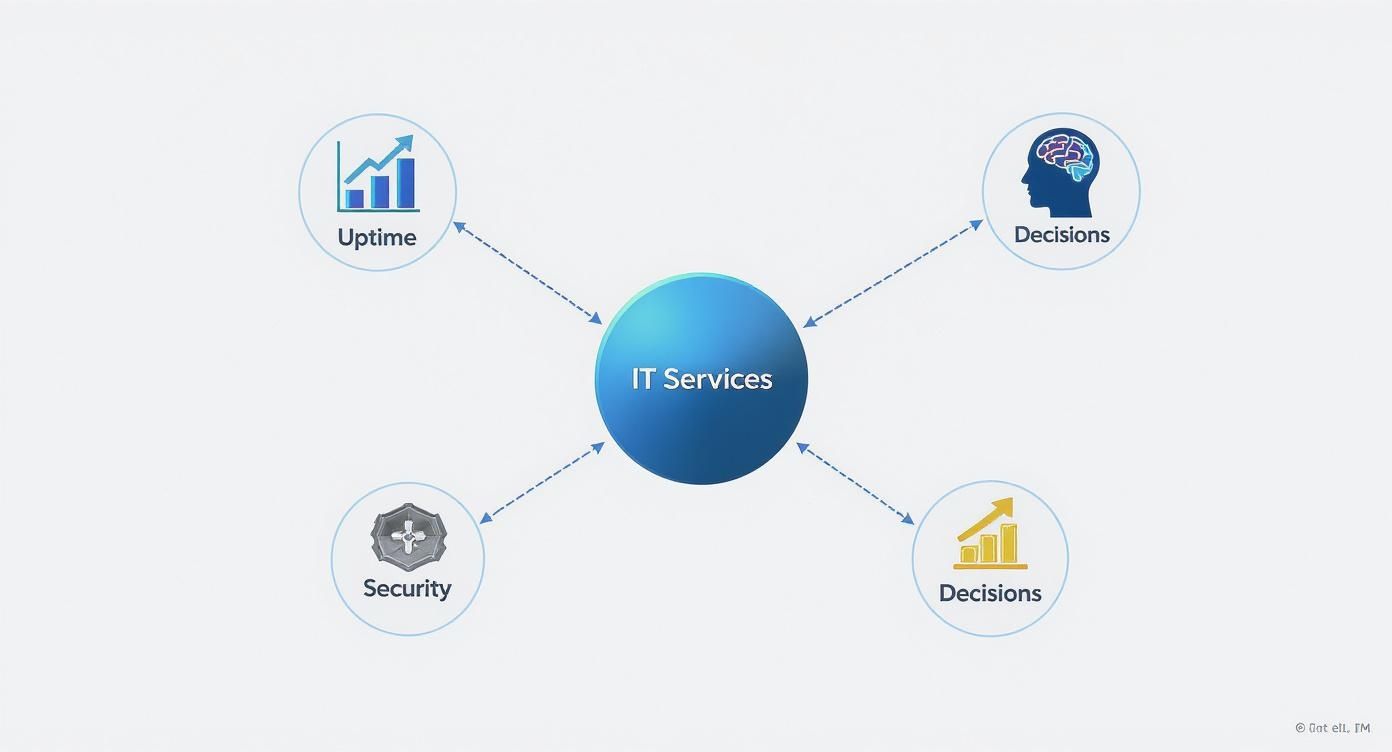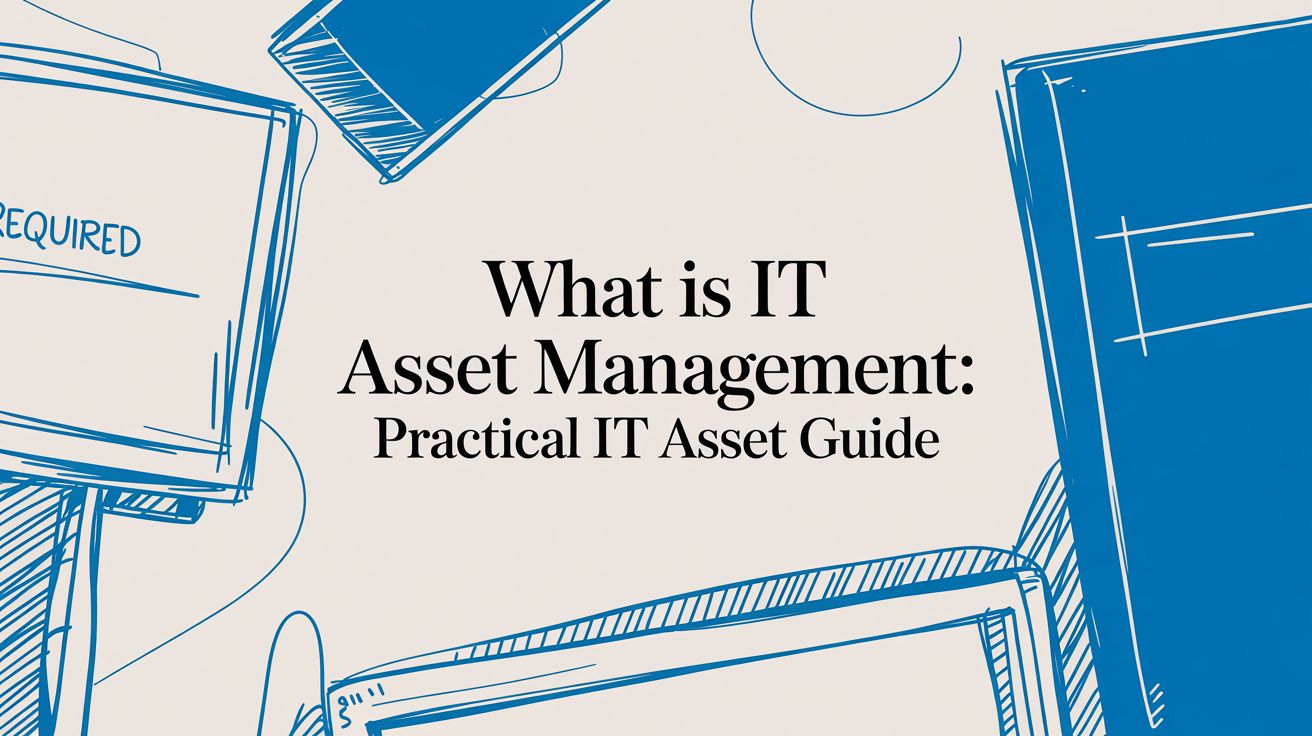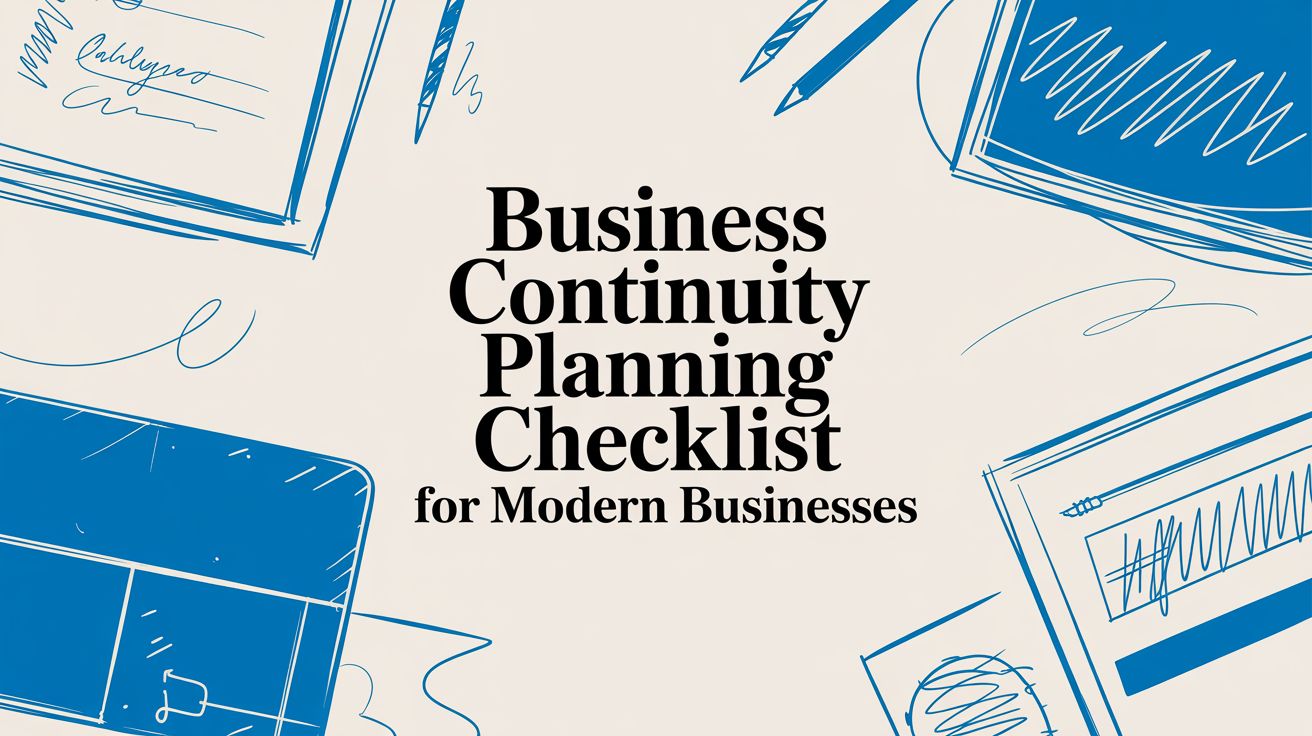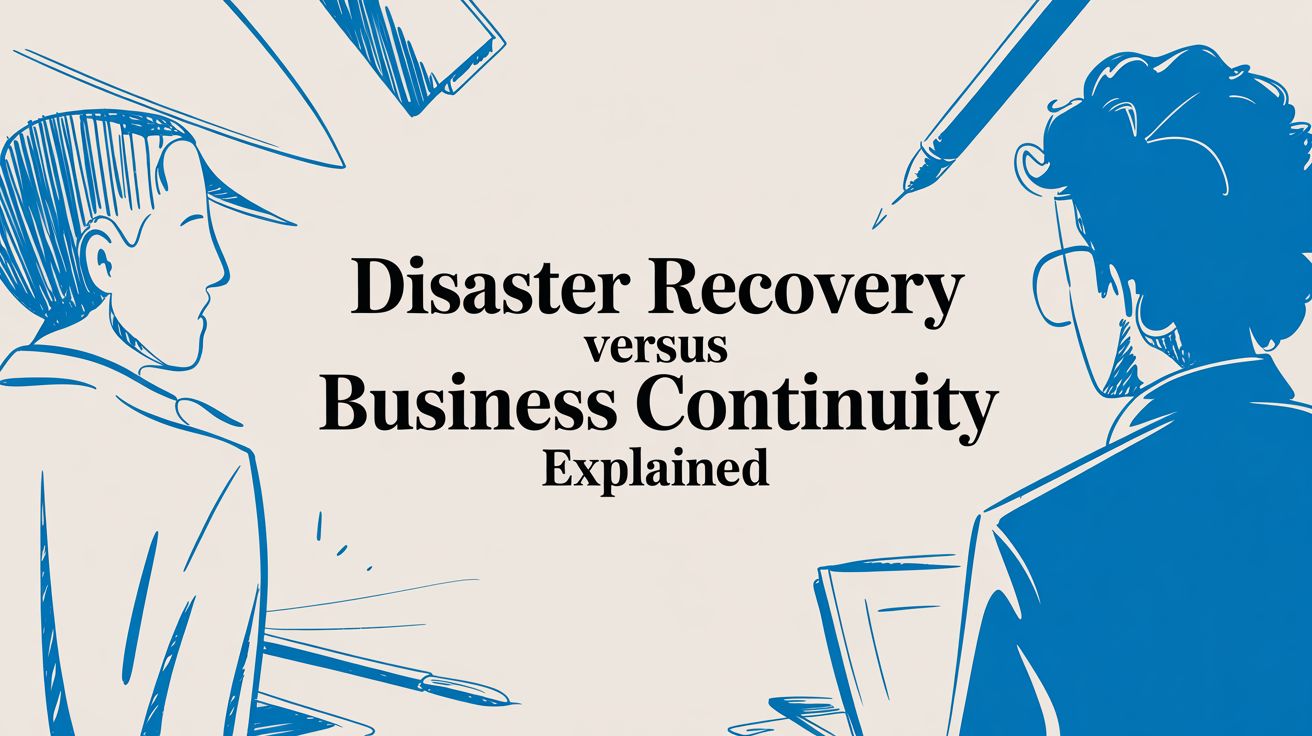IT Services for Manufacturing: A Guide for Small & Mid-Sized Businesses
In a modern manufacturing plant, IT services are the central nervous system. They're the invisible threads connecting every machine, process, and person on the floor, turning a constant flood of operational data into smart, profitable decisions. This isn't about fixing computers anymore. A strategic managed IT partner ensures every component works in perfect harmony to boost uptime, lock down security, and sharpen your competitive edge.
How Managed IT Services Drive Modern Manufacturing
It’s time to ditch the old-school view of IT as the department you only call when something is broken. In today’s smart factories, Information Technology (IT) and Operational Technology (OT)—the hardware and software actually running the equipment on the floor—are becoming one. This blend is the very foundation of Industry 4.0, where data coming straight off the machinery informs business strategy in the blink of an eye.
Picture your entire operation as a complex orchestra. Your CNC machines, robotic arms, ERP systems, and cloud databases are all different instruments. To get them to produce a symphony of seamless production instead of just a lot of noise, you need a conductor.
A managed IT service provider (MSP) is that conductor. They keep every digital instrument tuned, secure, and playing in sync with all the others. This harmony isn't just about running smoothly; it's about staying alive and growing in a competitive market by leveraging proactive IT support, robust cybersecurity, and modern cloud solutions.
From Cost Center To Profit Driver
For years, many small and mid-sized manufacturers saw IT as a necessary evil—a frustrating line item on the budget. A proactive approach to IT services for manufacturing completely flips that idea on its head. Instead of just reacting to problems after they happen, a managed services strategy is all about preventing them in the first place.
This shift from reactive to proactive creates real, measurable results for your business:
- Maximized Uptime: Constant monitoring can spot and fix potential problems with network gear, servers, or production equipment before they can trigger a costly shutdown. For example, a managed IT partner's monitoring tools might detect that a server's hard drive is failing, allowing them to replace it overnight instead of having it crash mid-shift.
- Enhanced Security: A robust, layered security plan is your best defense against cyber threats like ransomware, protecting your valuable intellectual property and operational data.
- Informed Decision-Making: When all your systems are connected and reliable, the data they generate becomes one of your most powerful assets. To really get the most out of it, exploring real-time data integration is a game-changer.
This infographic breaks down how essential IT services support the core pillars of a successful manufacturing operation.

As you can see, a solid IT foundation isn’t just about the tech itself. It's about enabling better business outcomes across the board—from the shop floor to the executive suite.
To help you see the connections more clearly, this table maps specific IT services to the direct impact they have on factory operations and your bottom line.
Key IT Services for Manufacturing Growth
This quick-reference guide shows how each service plays a vital role in building a more resilient, secure, and profitable manufacturing business.
The Growing Need For Specialized IT
Investment in technology within the manufacturing sector is skyrocketing. The global IT services market is on track to hit nearly USD 2.36 trillion by 2030, and manufacturing is a huge driver of that growth, thanks to things like IoT and AI. More telling, managed security services are seeing the highest growth rate as factories become more connected and, therefore, more vulnerable.
This trend makes one thing crystal clear: manufacturers without a smart, proactive IT strategy are going to be left behind. Understanding the value of outsourcing your IT is the first step. You can dive deeper into the benefits by checking out our guide to IT managed services.
Securing Your Factory from Modern Cyber Threats
When you're a manufacturer, a cyberattack isn't just an IT headache—it's a production shutdown. Imagine your entire line grinding to a halt because ransomware has locked up the very systems that control your machinery. To protect your operations, you need far more than basic antivirus software. You need a tough, multi-layered security strategy built for the realities of today's sophisticated attacks.
Think of your factory's security like a medieval fortress. One wall just won't cut it. You need an outer wall, an inner wall, guards on patrol, and a heavily fortified keep at the very center. In cybersecurity, this means creating layers of defense that work together to catch threats at every possible entry point.

This layered approach is non-negotiable because threats can pop up anywhere. A common and dangerous threat is phishing, where an employee clicks a malicious link in an email. Effective security awareness training is crucial to building a human firewall, teaching your team to recognize and report these attempts before they cause damage.
Building Your Digital Fortress
A solid security plan for any manufacturing environment has a few critical components. Each layer handles a different kind of risk, so if one defense is bypassed, another is already in place to stop the attack.
- Endpoint Protection: This is your first line of defense. It secures every single device connected to your network, from the PCs in the front office to the tablets and terminals on the shop floor. Modern Endpoint Detection and Response (EDR) solutions are much smarter than old-school antivirus, using advanced threat detection to stop malware and ransomware before they can ever run.
- Advanced Firewalls and Network Segmentation: Your firewall is the main gatekeeper, watching over all the traffic coming in and out of your network. But network segmentation adds another crucial layer by creating internal walls. It isolates your corporate IT network from your sensitive Operational Technology (OT) network, which keeps a breach in one area from spreading to the other.
- Managed Detection and Response (MDR): This is the equivalent of having a 24/7 security team actively hunting for threats. MDR services combine powerful technology with human expertise to constantly monitor your network, investigate anything that looks suspicious, and neutralize threats instantly—before they can do any real damage.
These elements are the foundation of a strong defense. If you want to dive deeper into how a dedicated team can strengthen your security, check out our guide on what managed security services are and how they work for businesses just like yours.
Real-World Scenario: A Shutdown Averted
A mid-sized parts manufacturer in Dallas recently saw this proactive approach pay off in a big way. An employee in their accounting department received a phishing email that looked like a real invoice from a major supplier. They clicked the link, accidentally downloading a piece of ransomware.
Without a layered defense, this would have been a disaster. The malware could have easily spread from that one PC across the entire network, encrypting server data and even shutting down the systems that control their CNC machines.
Instead, their managed security solution stopped the attack dead in its tracks. The advanced endpoint protection on the employee’s computer immediately caught and quarantined the malicious file. At the same time, the MDR service flagged the unusual network activity and alerted the security team, who quickly isolated the machine to prevent any chance of it spreading.
The result? What could have been a devastating, multi-day shutdown became a minor, 15-minute disruption for a single employee. This story shows that investing in robust IT services for manufacturing security isn't just an expense—it's a direct investment in your uptime and your ability to keep the business running.
Keeping Production Lines Running with Proactive IT Management
Let's be honest: waiting for a critical piece of equipment on your factory floor to break is probably the most expensive IT strategy you can have. The old "break-fix" model—where you only call for help after a system goes down—is a surefire way to bring production to a screeching halt. Modern IT services for manufacturing, however, completely flip that script. The focus is on preventing downtime before it ever has a chance to happen.
This shift from reactive to proactive is what managed IT is all about. Instead of seeing technology as an unpredictable cost center that only gets attention when it fails, you start treating it as a strategic asset. When you invest in continuous oversight, IT stops being a source of headaches and becomes a key driver of reliability and consistent output.

It’s this proactive philosophy, powered by specialized tools and a dedicated team working behind the scenes, that keeps your operations stable and secure.
The Power of Remote Monitoring and Maintenance
So, how does this work in practice? The engine driving it all is Remote Monitoring and Maintenance (RMM). Think of RMM as a 24/7 digital watchman for your entire tech infrastructure. It’s a sophisticated software platform that keeps a constant, vigilant eye on the health and performance of every server, workstation, network switch, and connected device in your facility.
This continuous monitoring is what allows IT experts to spot trouble brewing long before it ever affects your production line.
For example, imagine a network switch connected to a vital CNC machine starts showing subtle signs of failure, like intermittent packet loss. RMM tools can catch this tiny anomaly, automatically flag it, and allow technicians to resolve the issue—often remotely—before the switch dies and takes that machine offline.
The ability to fix problems before they cause downtime is a total game-changer for manufacturers. Instead of losing hours or even days of production, the issue gets handled during scheduled maintenance or off-peak hours, keeping your operations running like clockwork.
From Unpredictable Expense to Strategic Asset
Moving to a proactive model also does wonders for your budget and planning. You can finally stop getting blindsided by huge repair bills or the sudden need for emergency equipment replacements and start planning for the future with confidence.
Here’s how a proactive partnership helps you get there:
- Smart Hardware Lifecycle Planning: Your IT provider keeps track of the age and performance of all your hardware. This means you can strategically budget for and replace aging equipment before it becomes an unreliable liability on the factory floor.
- Optimized Performance: Regular, ongoing maintenance—like applying security patches (patch management) and fine-tuning systems—ensures everything runs at peak efficiency.
- Co-Managed IT Partnerships: Already have an in-house IT person or a small team? A co-managed model can be the perfect force multiplier. A managed services provider brings enterprise-grade tools, specialized expertise, and extra hands, freeing up your team to focus on strategic projects while the provider handles the day-to-day monitoring and support.
A key part of proactive IT management is understanding the difference between predictive vs preventive maintenance and applying the right strategy to the right systems for maximum efficiency. By putting these practices into place, you turn IT into a dependable asset that directly supports your production goals and protects your bottom line. PWR Technologies specializes in building these proactive maintenance plans for businesses in Dallas and Memphis.
Keeping Operations Running When Things Go Wrong
In a manufacturing plant, downtime isn't just an inconvenience—it's a direct shot to your revenue. A lot of businesses think a simple data backup is all they need, but that's a risky assumption. That’s where a comprehensive Business Continuity and Disaster Recovery (BCDR) plan comes in.
Think of it this way: having a backup is like keeping a fire extinguisher in the kitchen. It’s great for a small, contained problem. A real business continuity plan, on the other hand, is like having the entire fire department's playbook—complete with evacuation routes, communication strategies, and a clear system to get you back up and running, fast.
That difference is everything. A backup is just one component of a much bigger strategy. The real goal is to keep your factory floor moving through any kind of crisis, whether it's a ransomware attack, a server crashing, or a natural disaster. Without a full plan, getting your data back is only half the fight; it could still take days or even weeks to get your operations back to normal.

A solid BCDR plan ensures every critical part of your operation can be restored in a planned, efficient sequence. This minimizes financial damage and, just as importantly, protects the trust you've built with your customers.
Building a Bulletproof Backup Strategy
The bedrock of any BCDR plan is a modern, reliable backup system. For years, the gold standard in the industry has been the 3-2-1 backup rule. It's a simple framework, but it's incredibly effective at safeguarding your data.
- Three Copies: Always have at least three copies of your data. This includes your original production data plus two backups.
- Two Media Types: Store your backups on at least two different types of media. For example, you might use an on-site network-attached storage (NAS) device and also save a copy to the cloud. This protects you if one storage format fails.
- One Off-Site Copy: Keep at least one of those backup copies in a completely separate physical location. If a fire or flood hits your facility, your off-site backup is untouched and ready to go.
This approach builds layers of redundancy, making sure you can recover no matter what happens to your primary systems. This kind of resilience is crucial in sectors like Electronic Manufacturing Services (EMS), which is projected to become a nearly USD 1.1 trillion industry by 2033. These companies depend on robust IT to manage intricate supply chains where data integrity is everything. You can read more on the role of IT in this space in this market analysis.
From Recovery to Continuity: A Real-World Example
A plastics manufacturer in Memphis saw the power of a tested BCDR plan up close. One morning, their main production server—the machine that ran all their scheduling and inventory software—had a catastrophic hardware failure. In the old days, that would have meant chaos: days of downtime, lost orders, and a lot of unhappy customers.
But because they had a modern hybrid-cloud BCDR solution, the story had a very different ending. Their managed IT provider was alerted instantly. The system automatically failed over to a virtual copy of the server that was already running in the cloud.
Within two hours, the manufacturer was completely back online, running on the cloud replica. Most employees barely noticed a hiccup. Production schedules stayed on track, and not a single customer order was late.
That’s what a true business continuity plan delivers. It’s not just about getting your files back; it’s about keeping your business in business. By shifting your mindset from simple backups to complete operational resilience, you can learn more about building a solid business continuity plan in Dallas, TX. This turns your IT from a potential weak point into one of your company's greatest strengths.
Unlocking Agility with Manufacturing Cloud Solutions
For a lot of manufacturers, "the cloud" still just means online file storage. But in a modern factory, it's so much more than a digital filing cabinet. Think of it as the central nervous system for your entire operation, connecting every piece of your business in real time. This is where IT services for manufacturing stop being a background support function and start driving real innovation and efficiency.
Imagine your engineers, your production line, and your sales team all working from the exact same, up-to-the-minute blueprint. That’s the kind of power the cloud brings to the table. Platforms like Microsoft 365 and Azure are designed to tear down the information silos that cause frustrating delays and costly miscommunications, creating a single source of truth for everyone.
This move toward smarter, more connected factories is clearly reflected in spending. A recent Deloitte report found that in 2024, manufacturers are dedicating around 30% of their operating budgets to technology. That's a huge jump from just 23% in 2023. Cloud computing is leading the charge, and it's easy to see why. A well-thought-out cloud strategy is no longer a "nice-to-have"—it's a must for growth. You can dive deeper into these global manufacturing market trends to see the full picture.
Practical Cloud Applications on the Factory Floor
Moving to the cloud isn't just a theoretical upgrade; it delivers tangible results you can see in your day-to-day work. A smart cloud setup bolsters security, provides incredible scalability, and makes teamwork seamless, turning raw data into your biggest competitive edge.
Here are a few real-world examples of how manufacturers are putting the cloud to work:
- Real-Time Design Collaboration: An engineer tweaks a CAD file for a new part and saves it to a shared platform like Microsoft SharePoint. Instantly, the production team on the shop floor can pull up the new specs on a tablet. This simple workflow completely eliminates the risk of building something from outdated plans.
- Cloud-Powered IoT Analytics: Sensors on your machinery can stream performance data directly to a cloud platform like Azure. This allows you to run powerful analytics to predict maintenance needs, spot production bottlenecks, and cut down on energy use—all without having to manage a massive server room on-site.
- Scalable ERP and CRM Systems: Running your Enterprise Resource Planning (ERP) or Customer Relationship Management (CRM) software in the cloud means it can flex and grow with your business. You can add new users or ramp up computing power during peak season without having to buy, install, and maintain expensive new hardware.
Finding the Right Fit: The Hybrid Cloud Model
Jumping headfirst into the public cloud isn't always the right move for manufacturers. You've got sensitive intellectual property, legacy systems that still do their job, and equipment that needs split-second response times. That kind of critical infrastructure often needs to stay on-premise. This is where the hybrid cloud model really shines.
A hybrid cloud strategy gives you the best of both worlds. It combines the rock-solid security and control of a private, on-site infrastructure with the unmatched flexibility and power of the public cloud.
This approach lets you keep mission-critical operational data on your own local servers for maximum performance and compliance, while using the public cloud for things like collaboration, data backups, and heavy-duty analytics.
Choosing the right cloud model is a critical decision. This table breaks down the most common options to help you figure out which one aligns best with your factory's needs.
Choosing the Right Cloud Model for Your Factory
Ultimately, a hybrid approach gives you a secure, scalable foundation to build on. To get a better handle on what this looks like in practice, you can explore our guide on building the right infrastructure and cloud strategy. By working with an IT partner who truly understands manufacturing, you can design a cloud solution that fits your factory like a glove.
Common Questions About Manufacturing IT Services
Deciding to bring in an IT partner is a big move, and it's completely normal for manufacturing leaders to have a few questions. We get it. Here are some straightforward answers to the most common concerns we hear, covering everything from budgeting to dealing with specialized shop floor equipment. The goal is to give you the clarity you need to make the right call for your business.
How Much Do Managed IT Services Cost for a Small Factory?
The best way to think about the cost of IT services for manufacturing isn't to look at a price tag. The real question is, "What is the true cost of unplanned downtime?" For most plants, a single hour of a dead production line can easily wipe out an entire month's IT support budget.
When you look at it that way, a predictable monthly plan that prevents those exact outages becomes one of the smartest investments you can make. The cost is built around your specific operation—things like the number of users, the complexity of your systems, and your security needs. We focus on creating a transparent budget that directly supports your business goals, turning IT from a surprise expense into a tool for profitability.
Can You Support Our Specialized OT and Legacy Equipment?
Absolutely. A managed IT provider specializing in manufacturing knows the critical connection between Information Technology (IT) and your Operational Technology (OT). Our job isn't to replace your equipment vendors; it's to work alongside them to make your entire operation more stable and secure.
We make sure the network infrastructure that your OT depends on—the digital foundation of your plant—is rock-solid and optimized. This means we're managing the network your PLCs are connected to and protecting the servers running your SCADA systems. By bridging that IT/OT gap and collaborating with your vendors, we help create a single, cohesive environment where everything just works.
How Do IT Services Improve Supply Chain Management?
Think of modern IT services as the engine that drives a strong, agile supply chain. A reliable infrastructure guarantees your ERP and inventory systems are always up and running, giving you the real-time data you need for accurate forecasting and quick decisions.
Secure cloud platforms allow for smooth collaboration with suppliers and logistics partners, cutting down on communication lags and keeping everyone in sync. More importantly, a solid business continuity plan ensures that a local problem, like a server crash or a cyberattack, doesn’t bring your entire supply chain to a screeching halt.
Good IT turns your supply chain from a reactive headache into a data-driven advantage, giving you better visibility and control from start to finish.
What Is the First Step to Working with an IT Provider?
The first move should always be a thorough technology assessment and vulnerability scan. Any reputable provider will want to understand your unique factory environment, your operational headaches, and your business goals before ever giving you a quote.
This initial diagnostic process is a deep dive into your current setup:
- Network Infrastructure: We’ll look at the health and performance of your switches, routers, and Wi-Fi.
- Cybersecurity Defenses: We'll hunt for potential weak spots in your firewalls, endpoint protection, and security policies.
- Data Backup and Recovery Processes: We’ll test if your current backups can actually get you back online fast enough after a disaster.
- Key Business Applications: We'll get a handle on how your critical software (like ERP and design tools) is set up and supported.
This is a collaborative session meant to pinpoint risks and find opportunities. The final result is a strategic technology roadmap built specifically for your business—a clear plan that fixes today's problems and sets you up for future growth. From there, we can put together a solution that delivers real, measurable value to your operation.
Ready to turn your technology into a competitive advantage? The team at PWR Technologies LLC specializes in providing proactive, secure, and reliable IT services for manufacturers in Dallas, TX, and Memphis, TN. Let's build a strategy that maximizes your uptime and protects your bottom line.




